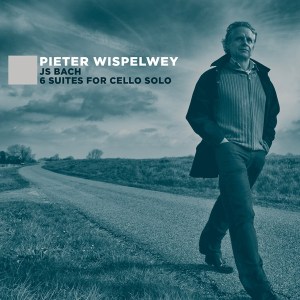 |
 |
|


alternatively
CD: MDT
AmazonUK
AmazonUS |
Johann Sebastian BACH
(1685-1750)
Six Suites for Cello Solo
Suite No. 1 in G major, BWV 1007 [17:00]
Suite No. 2 in D minor, BWV 1008 [19:33]
Suite No. 3 in C major, BWV 1009 [20:38
Suite No. 4 in E-flat major, BWV 1010 [23:20]
Suite No. 5 in C minor, BWV 1011 [22:28]
Suite No. 6 in D major, BWV 1012 [30:24]
DVD: 392, Pieter Wispelwey and the Bach Cello Suites [52:00]
 Pieter Wispelwey (baroque cello and piccolo cello)
Pieter Wispelwey (baroque cello and piccolo cello)
rec. June 2012, Serendipitous Studio, Mechelen, Belgium.
 EVIL PENGUIN RECORDS EPRC012 [2 CDs: 54:00 + 79:00 + (DVD) 52:00]
EVIL PENGUIN RECORDS EPRC012 [2 CDs: 54:00 + 79:00 + (DVD) 52:00]
|
|
|
In this third recording of Bach's cello suites, Pieter Wispelwey
makes one important change to the way he plays these works.
His cello is tuned at 392 Hz, the "Cothen" tuning, a half-tone
lower than the "standard" tuning of 415. With gut strings, which
Wispelwey uses, this can present problems. He mentions, in the
liner notes, an occasion where he had to tune back to 415 Hz
for a concert because of heat and humidity. In the studio, these
things can be controlled, and the lower pitch gives a stronger
foundation to certain of the suites.
Wispelwey is an odd cellist. His style can be harsh and aggressive;
he sometimes attacks the instrument. He plays hard. There are
many movements where you can hear his fingers tapping loudly
on the instrument's fingerboard; at times this is annoying.
This recording has an attractive sound, but is miked very closely,
and I found myself wincing as I heard the sound of his fingers
at certain times. This begins fairly early, in the Courante
of the first suite, and occurs many times throughout.
Wispelwey also uses little or no vibrato. I listened very closely
but I didn't notice any. This works well with the Bach suites
but overall I don't get the impression of the music flowing
very much. Comparing this with his second recording on Channel
Classics, I find the sound and playing much more comfortable.
The cello is miked with a little more distance, and the finger
sounds are muted, and don't disturb the music. Also, on this
recording, the volume is quite high, much higher than the Channel
Classics recording, so if you start playing the disc at your
stereo's normal volume, you'll be a bit surprised.
For a comparison, I listened to Anner Bylsma's first recording
of the cello suites, also at a 392 Hz pitch, but with a recording
quality that is inferior: the cello sounds distant and thin.
Bylsma puts more "music" into these works; there is more legato,
more rubato, and the music flows much better. Bylsma has long
been my favourite with these works, in spite of the recording
quality of those discs. I don’t like his second recording
as much.
The set also includes a 52-minute DVD about the suites, with
Wispelwey discussing the works, along with two scholars, Laurence
Dreyfus and John Butt. We also see some excerpts from a performance
of the suites at Oxford University. This film gives good insights
into Wispelwey's perspective.
Wispelwey offers an interesting approach to the suites, but
his impulsiveness doesn't work for me. In the documentary included
on a DVD with this set, Wispelwey’s excessive energy is
apparent when he talks. That same energy seems to be present
in his playing. For example, the Courante of the third suite
sounds as though the music is almost out of control, as if the
tempo is too fast to maintain a musical line. While this set
is well played, it's not the way I like the cello suites. You
may think differently, and you should certainly check out sound
samples of these works on the internet.
Kirk McElhearn
Kirk McElhearn writes about more than just music on his blog
Kirkville.
Masterwork Index: Bach
cello suites
|
|

